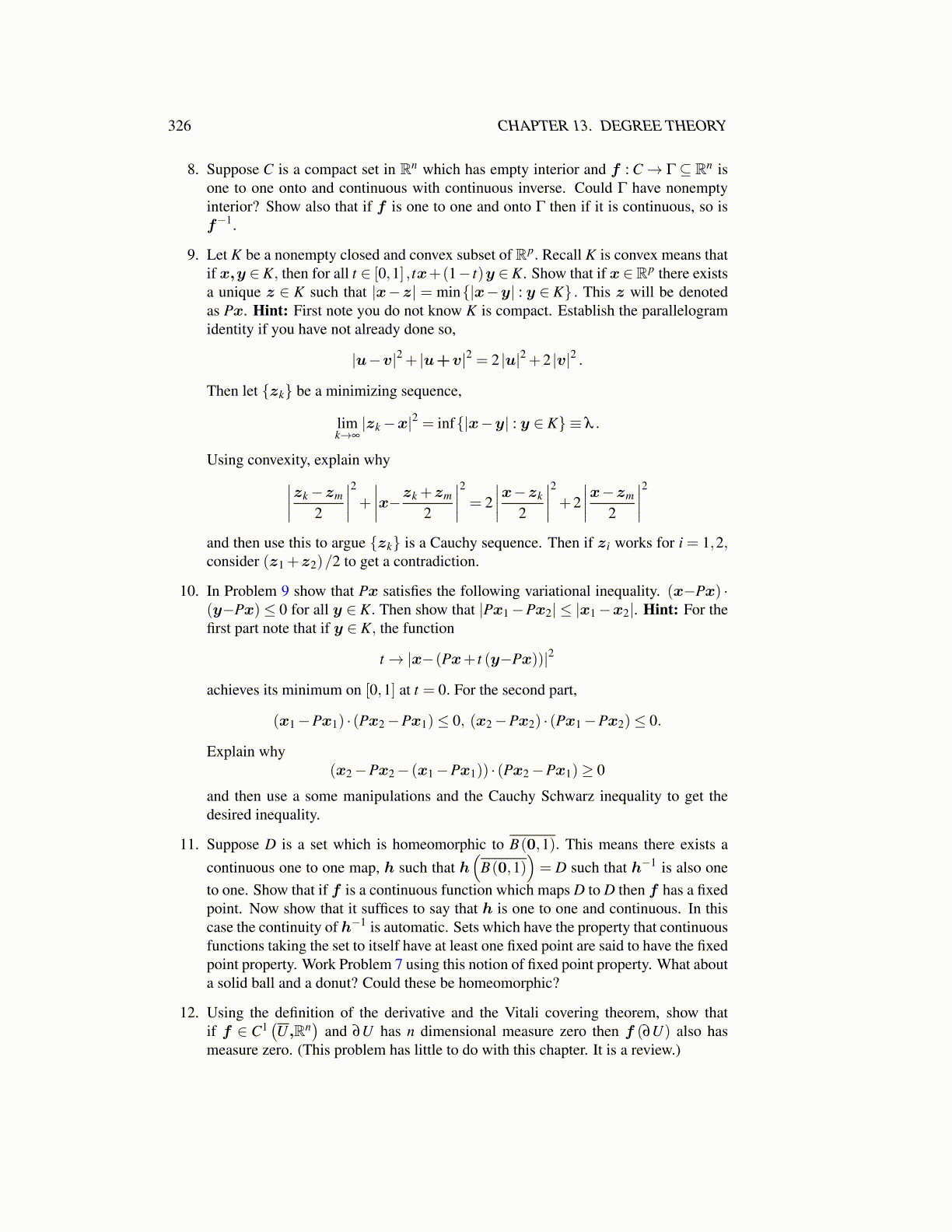
326 CHAPTER 13. DEGREE THEORY
8. Suppose C is a compact set in Rn which has empty interior and f : C→ Γ ⊆ Rn isone to one onto and continuous with continuous inverse. Could Γ have nonemptyinterior? Show also that if f is one to one and onto Γ then if it is continuous, so isf−1.
9. Let K be a nonempty closed and convex subset of Rp. Recall K is convex means thatif x,y ∈K, then for all t ∈ [0,1] , tx+(1− t)y ∈K. Show that if x∈Rp there existsa unique z ∈ K such that |x−z| = min{|x−y| : y ∈ K} . This z will be denotedas Px. Hint: First note you do not know K is compact. Establish the parallelogramidentity if you have not already done so,
|u−v|2 + |u+v|2 = 2 |u|2 +2 |v|2 .
Then let {zk} be a minimizing sequence,
limk→∞
|zk−x|2 = inf{|x−y| : y ∈ K} ≡ λ .
Using convexity, explain why∣∣∣∣zk−zm
2
∣∣∣∣2 + ∣∣∣∣x−zk +zm
2
∣∣∣∣2 = 2∣∣∣∣x−zk
2
∣∣∣∣2 +2∣∣∣∣x−zm
2
∣∣∣∣2and then use this to argue {zk} is a Cauchy sequence. Then if zi works for i = 1,2,consider (z1 +z2)/2 to get a contradiction.
10. In Problem 9 show that Px satisfies the following variational inequality. (x−Px) ·(y−Px)≤ 0 for all y ∈ K. Then show that |Px1−Px2| ≤ |x1−x2|. Hint: For thefirst part note that if y ∈ K, the function
t→ |x−(Px+ t (y−Px))|2
achieves its minimum on [0,1] at t = 0. For the second part,
(x1−Px1) · (Px2−Px1)≤ 0, (x2−Px2) · (Px1−Px2)≤ 0.
Explain why(x2−Px2− (x1−Px1)) · (Px2−Px1)≥ 0
and then use a some manipulations and the Cauchy Schwarz inequality to get thedesired inequality.
11. Suppose D is a set which is homeomorphic to B(0,1). This means there exists acontinuous one to one map, h such that h
(B(0,1)
)= D such that h−1 is also one
to one. Show that if f is a continuous function which maps D to D then f has a fixedpoint. Now show that it suffices to say that h is one to one and continuous. In thiscase the continuity of h−1 is automatic. Sets which have the property that continuousfunctions taking the set to itself have at least one fixed point are said to have the fixedpoint property. Work Problem 7 using this notion of fixed point property. What abouta solid ball and a donut? Could these be homeomorphic?
12. Using the definition of the derivative and the Vitali covering theorem, show thatif f ∈ C1
(U,Rn
)and ∂U has n dimensional measure zero then f (∂U) also has
measure zero. (This problem has little to do with this chapter. It is a review.)